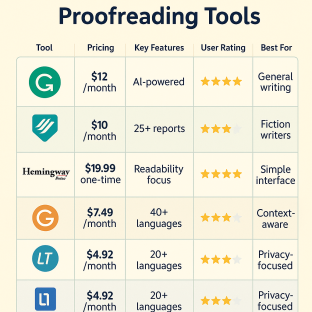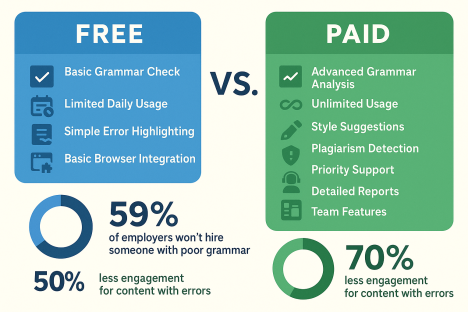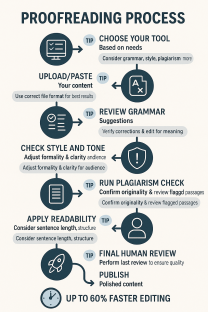We get it â you’re busy creating content, writing essays, crafting social media posts, and probably juggling a million other things. The last thing you want is embarrassing typos or grammar fails going viral for all the wrong reasons.
Whether you’re writing that crucial college application essay, your first job cover letter, or even your next TikTok caption, having clean, error-free writing is absolutely essential. That’s where online proofreading tools come in clutch â they’re like having a grammar guru in your pocket, ready to save you from those cringe-worthy mistakes that could totally tank your credibility.
These digital writing assistants have revolutionized how we approach editing and proofreading, making it easier than ever to produce polished, professional content that actually hits different.
What Are Online Proofreading Tools?
Online proofreading tools are digital writing assistants designed to help writers identify and correct errors in their text. These sophisticated software solutions use advanced algorithms, artificial intelligence, and natural language processing to detect grammar mistakes, spelling errors, punctuation issues, and style inconsistencies. Unlike traditional spell checkers, modern proofreading tools offer comprehensive writing analysis that goes beyond basic error detection.
The evolution of proofreading technology has transformed the writing landscape. From simple spell checkers to AI-powered writing assistants, these tools now provide real-time feedback, style suggestions, and even tone analysis. They serve as virtual editors, helping writers improve their content quality while learning proper writing techniques.
Why Online Proofreading Tools Matter
In today’s digital-first world, written communication dominates professional and personal interactions. Email correspondence, social media posts, academic papers, business reports, and marketing content all require polished writing. Poor grammar and spelling can damage credibility, reduce engagement, and create negative impressions.
Research shows that 59% of employers would not hire someone with poor grammar skills. Additionally, content with spelling and grammar errors receives 70% less engagement on social media platforms. These statistics highlight the critical importance of error-free writing in achieving personal and professional success.
Online proofreading tools democratize access to professional editing services. They provide instant feedback, cost-effective solutions, and educational value that helps writers improve their skills over time. Whether you’re a student, professional writer, business owner, or casual blogger, these tools can significantly enhance your writing quality.
Key Features to Look for in Proofreading Tools

Grammar and Spell Check
The foundation of any good proofreading tool is accurate grammar and spell checking. Look for tools that can identify complex grammatical errors, not just simple spelling mistakes. Advanced grammar checkers should recognize context-dependent errors, subject-verb disagreements, and improper sentence structures.
Style and Tone Analysis
Modern proofreading tools analyze writing style and tone to ensure consistency and appropriateness for your target audience. They can identify passive voice overuse, suggest more engaging word choices, and help maintain a consistent tone throughout your document.
Plagiarism Detection
Many comprehensive proofreading platforms include plagiarism checking features. This functionality compares your text against billions of web pages and academic databases to ensure originality and proper attribution.
Real-time Editing
The best proofreading tools provide real-time suggestions as you type. This immediate feedback allows writers to correct errors instantly, improving workflow efficiency and reducing revision time.
Multi-platform Integration
Look for tools that integrate seamlessly with your preferred writing platforms. Whether you use Microsoft Word, Google Docs, web browsers, or mobile devices, your proofreading tool should work wherever you write.
Top 15 Best Online Proofreading Tools
1. Grammarly
Grammarly stands as the most popular and widely recognized online proofreading tool. With over 30 million daily users, it offers comprehensive grammar checking, style suggestions, and tone detection. The platform uses advanced AI to provide contextual writing feedback.
Key Features:
- Real-time grammar and spell checking
- Style and clarity suggestions
- Tone detector
- Browser extension and mobile app
- Microsoft Office integration
- Plagiarism checker (Premium)
Pricing:
- Free version with basic features
- Premium: $12/month (annual plan)
- Business: $15/member/month
Pros:
- User-friendly interface
- Excellent browser integration
- Comprehensive writing feedback
- Strong mobile app
Cons:
- Premium features require subscription
- Can be overly aggressive with suggestions
- Limited customization options
2. ProWritingAid
ProWritingAid positions itself as a comprehensive writing mentor, offering detailed analysis reports and in-depth writing insights. It’s particularly popular among fiction writers and content creators who need thorough editing support.
Key Features:
- 25+ writing reports
- Grammar and style checking
- Readability analysis
- Contextual thesaurus
- Manuscript critique
- Integration with major writing platforms
Pricing:
- Free version (limited)
- Premium: $10/month
- Premium Plus: $12/month
- Lifetime license: $399
Pros:
- Detailed writing analysis
- Excellent for long-form content
- Affordable pricing
- Comprehensive reports
Cons:
- Interface can be overwhelming
- Slower processing for large documents
- Learning curve for new users
3. Hemingway Editor
The Hemingway Editor focuses on improving readability and clarity by identifying complex sentences, passive voice, and difficult-to-read passages. It’s named after Ernest Hemingway’s clear, concise writing style.
Key Features:
- Readability grade level
- Sentence complexity analysis
- Passive voice detection
- Adverb highlighting
- Word count and reading time
- Clean, distraction-free interface
Pricing:
- Web version: Free
- Desktop app: $19.99 (one-time purchase)
Pros:
- Simple, intuitive interface
- Excellent for improving clarity
- Affordable one-time purchase
- No subscription required
Cons:
- Limited grammar checking
- Basic feature set
- No plagiarism detection
- Minimal integration options
4. Ginger Software
Ginger Software offers AI-powered writing assistance with a focus on context-based corrections. It’s particularly effective for non-native English speakers and provides translation capabilities.
Key Features:
- Context-based spell checking
- Grammar correction
- Sentence rephrasing
- Translation support (40+ languages)
- Text reader functionality
- Personal trainer feature
Pricing:
- Limited free version
- Premium: $13.99/month
- Annual plan: $7.49/month
Pros:
- Excellent for non-native speakers
- Translation capabilities
- Context-aware corrections
- Mobile keyboard support
Cons:
- Limited free version
- Interface feels dated
- Fewer integrations than competitors
- Higher pricing
5. WhiteSmoke
WhiteSmoke provides comprehensive writing assistance with grammar checking, style improvement, and plagiarism detection. It’s designed for business professionals and academic writers.
Key Features:
- Grammar and spell checking
- Style suggestions
- Plagiarism checker
- Templates library
- Translation support
- Writing tutorials
Pricing:
- Essential: $8.33/month (annual)
- Premium: $13.33/month (annual)
- Business: $22.99/month (annual)
Pros:
- Comprehensive feature set
- Business-focused tools
- Template library
- Good customer support
Cons:
- Higher pricing
- Limited free version
- Interface needs modernization
- Slower updates
6. LanguageTool
LanguageTool is an open-source proofreading platform that supports over 20 languages. It’s particularly valuable for multilingual writers and organizations.
Key Features:
- 20+ language support
- Grammar and style checking
- Personal dictionary
- Browser extensions
- API access
- Privacy-focused (no text storage)
Pricing:
- Free version (limited)
- Premium: $4.92/month (annual)
Pros:
- Multi-language support
- Privacy-focused approach
- Open-source foundation
- Affordable pricing
- No text storage
Cons:
- Limited advanced features
- Smaller user community
- Fewer integrations
- Basic interface design
7. PaperRater
PaperRater offers AI-powered proofreading with a focus on academic writing. It provides grammar checking, plagiarism detection, and writing suggestions specifically tailored for students and educators.
Key Features:
- Grammar and spell checking
- Plagiarism detection
- Writing suggestions
- Vocabulary builder
- Automated scoring
- Educational focus
Pricing:
- Free version available
- Premium: $11.21/month
Pros:
- Academic writing focus
- Free plagiarism checking
- Automated scoring system
- Student-friendly pricing
Cons:
- Limited commercial features
- Basic interface
- Fewer style options
- Limited integration
8. After the Deadline
After the Deadline is a lightweight, open-source proofreading tool that focuses on contextual spell checking and grammar correction. It’s popular among WordPress users and developers.
Key Features:
- Contextual spell checking
- Grammar error detection
- Misused word identification
- WordPress integration
- Open-source platform
- Developer-friendly API
Pricing:
- Free to use
- Open-source
Pros:
- Completely free
- Open-source flexibility
- WordPress integration
- Lightweight and fast
Cons:
- Limited feature set
- Basic interface
- No advanced style checking
- Minimal support
9. Reverso
Reverso combines proofreading with translation services, making it ideal for multilingual content creators and international businesses.
Key Features:
- Grammar and spell checking
- Translation services
- Context examples
- Conjugation assistance
- Language learning tools
- Mobile apps
Pricing:
- Free version available
- Premium: $9.99/month
Pros:
- Translation integration
- Multiple language support
- Context examples
- Learning tools
Cons:
- Limited proofreading features
- Focus on translation
- Basic grammar checking
- Limited customization
10. Scribens
Scribens offers free grammar checking with a focus on simplicity and ease of use. It’s particularly popular among students and casual writers.
Key Features:
- Grammar and spell checking
- Style suggestions
- Vocabulary enhancement
- Statistics and readability
- Browser extension
- API access
Pricing:
- Free version
- Premium: $9.90/month
Pros:
- Completely free basic version
- Simple interface
- Good for beginners
- Multiple language support
Cons:
- Limited advanced features
- Basic design
- Fewer integrations
- Limited customer support
11. SpellCheckPlus
SpellCheckPlus specializes in interactive grammar checking with detailed explanations for each correction. It’s designed for educational purposes and language learning.
Key Features:
- Interactive grammar lessons
- Detailed error explanations
- Customizable checking levels
- Progress tracking
- Educational focus
- Batch processing
Pricing:
- Free version (limited)
- Pro: $14.99/year
Pros:
- Educational approach
- Detailed explanations
- Affordable pricing
- Progress tracking
Cons:
- Limited modern features
- Basic interface
- Fewer integrations
- Small user base
12. Virtual Writing Tutor
Virtual Writing Tutor is a free educational proofreading tool designed specifically for ESL students and language learners.
Key Features:
- Grammar checking
- Vocabulary suggestions
- Target structure checking
- Paraphrase checking
- IELTS/TOEFL preparation
- Educational resources
Pricing:
- Free to use
Pros:
- Completely free
- Educational focus
- ESL-friendly features
- Test preparation tools
Cons:
- Limited advanced features
- Basic interface design
- No commercial features
- Limited integrations
13. Grammar Slammer
Grammar Slammer combines proofreading with comprehensive grammar reference materials. It’s designed for writers who want to understand the rules behind corrections.
Key Features:
- Grammar checking
- Comprehensive grammar guide
- Style suggestions
- Writing tips
- Reference materials
- Offline capability
Pricing:
- One-time purchase: $49
Pros:
- Comprehensive grammar reference
- One-time purchase
- Offline functionality
- Educational value
Cons:
- Outdated interface
- Limited online features
- No cloud sync
- Steep learning curve
14. Slick Write
Slick Write offers free proofreading with a focus on flow, structure, and style analysis. It’s popular among bloggers and content creators.
Key Features:
- Grammar and spell checking
- Flow and structure analysis
- Readability statistics
- Vocabulary suggestions
- Prepositional phrase detection
- Sentence variety analysis
Pricing:
- Free to use
Pros:
- Completely free
- Unique flow analysis
- Good for content creators
- No registration required
Cons:
- Limited features
- Basic interface
- No advanced integrations
- Minimal support
15. EditMinion
EditMinion is a simple, free proofreading tool that focuses on identifying common writing issues like weak words, redundancies, and clichés.
Key Features:
- Weak word identification
- Redundancy detection
- Cliché highlighting
- Adverb tracking
- Reading level analysis
- Simple copy-paste interface
Pricing:
- Free to use
Pros:
- Completely free
- Focus on style improvement
- Simple to use
- No registration required
Cons:
- Very basic features
- No grammar checking
- Limited functionality
- Minimal interface
Free vs. Paid Proofreading Tools

Free Tool Advantages
Free proofreading tools provide basic error detection without financial commitment. They’re perfect for casual writers, students on tight budgets, and anyone needing occasional proofreading assistance. Most free tools offer:
- Basic grammar and spell checking
- Simple error highlighting
- Limited daily usage
- Basic browser integration
- Entry-level writing suggestions
Paid Tool Benefits
Premium proofreading tools offer advanced features that significantly enhance writing quality:
- Advanced grammar analysis
- Style and tone suggestions
- Plagiarism detection
- Priority customer support
- Unlimited usage
- Advanced integrations
- Detailed writing reports
- Personal writing insights
Cost-Benefit Analysis
For professional writers, content creators, and business professionals, paid tools typically provide excellent return on investment. The time saved and quality improvements often justify monthly subscription costs. Students and casual writers may find free tools sufficient for their needs.
Industry-Specific Recommendations
Academic Writing
Students and researchers benefit from tools offering:
- Citation checking
- Academic tone analysis
- Plagiarism detection
- Research paper formatting
- Scholarly writing suggestions
Recommended tools: ProWritingAid, Grammarly Premium, PaperRater
Business Communication
Professional environments require:
- Formal tone maintenance
- Email integration
- Team collaboration features
- Brand voice consistency
- Document security
Recommended tools: Grammarly Business, WhiteSmoke Business, ProWritingAid Teams
Creative Writing
Fiction writers need:
- Character name consistency
- Dialogue formatting
- Manuscript structure analysis
- Genre-specific suggestions
- Long document handling
Recommended tools: ProWritingAid, Hemingway Editor, Scrivener integration
Content Marketing
Digital marketers require:
- SEO optimization suggestions
- Readability analysis
- Tone consistency
- Brand voice alignment
- Multi-platform publishing
Recommended tools: Grammarly, ProWritingAid, Hemingway Editor
Tips for Maximizing Proofreading Tool Effectiveness

Understand Tool Limitations
No proofreading tool is perfect. They excel at identifying technical errors but may struggle with:
- Creative language use
- Industry-specific terminology
- Cultural context
- Intentional style choices
- Complex sentence structures
Combine Multiple Tools
Different tools have varying strengths. Consider using:
- Primary tool for comprehensive checking
- Secondary tool for style analysis
- Specialized tools for specific needs
- Human review for final quality assurance
Customize Settings
Most advanced tools allow customization:
- Set appropriate formality levels
- Choose regional spelling preferences
- Select relevant writing goals
- Configure industry-specific dictionaries
- Adjust suggestion sensitivity
Learn from Suggestions
Use proofreading tools as learning opportunities:
- Read explanation details
- Understand grammar rules
- Practice suggested improvements
- Build personal style guides
- Track common error patterns
Maintain Human Judgment
Technology should enhance, not replace, human creativity:
- Review all suggestions critically
- Maintain your unique voice
- Consider context and audience
- Trust your instincts
- Seek human feedback when needed
Common Proofreading Mistakes to Avoid
Over-reliance on Tools
While proofreading tools are powerful, they shouldn’t replace careful human review. Common over-reliance issues include:
- Accepting all suggestions blindly
- Ignoring context and creativity
- Missing subtle errors
- Losing personal writing voice
- Failing to understand corrections
Ignoring Context
Automated tools may not understand:
- Industry-specific language
- Creative writing techniques
- Cultural references
- Intentional style choices
- Audience-specific communication
Rushing the Process
Effective proofreading requires time and attention:
- Allow adequate review time
- Read content aloud
- Check formatting and structure
- Verify facts and references
- Consider overall flow and coherence
Future of Online Proofreading
AI Advancement
Artificial intelligence continues revolutionizing proofreading technology:
- Natural language processing improvements
- Context understanding enhancement
- Personalized writing assistance
- Voice and tone analysis
- Predictive writing suggestions
Integration Expansion
Future tools will likely offer:
- Seamless cross-platform integration
- Real-time collaborative editing
- Advanced API capabilities
- Voice-to-text proofreading
- Mobile-first design approaches
Specialized Applications
Emerging trends include:
- Industry-specific tools
- Multilingual capabilities
- Accessibility improvements
- Educational gamification
- Professional certification integration
Conclusion
Online proofreading tools have become indispensable resources for writers across all industries and skill levels. From free basic checkers to comprehensive premium platforms, these digital assistants help create polished, professional content while improving writing skills over time.
The key to success lies in choosing the right tool for your specific needs, understanding its capabilities and limitations, and using it as part of a broader writing improvement strategy. Whether you’re a student crafting academic papers, a professional managing business communications, or a creative writer developing the next bestseller, the right proofreading tool can significantly enhance your writing quality and efficiency.
As technology continues advancing, these tools will become even more sophisticated, offering personalized assistance that adapts to individual writing styles and goals. The future of writing looks bright, with AI-powered assistants helping writers communicate more effectively while preserving their unique voices and creativity.
Remember that while proofreading tools are powerful allies, they work best when combined with human judgment, creativity, and a commitment to continuous learning. Invest time in understanding your chosen tool’s features, customize settings for your specific needs, and always maintain the human element that makes writing truly engaging and meaningful.
By leveraging these online proofreading tools effectively, you’ll not only improve your current writing but also develop skills that will serve you throughout your personal and professional journey. The investment in quality writing assistance pays dividends in credibility, engagement, and success across all written communication endeavors.







